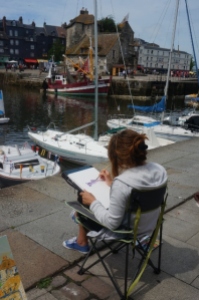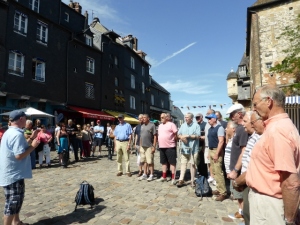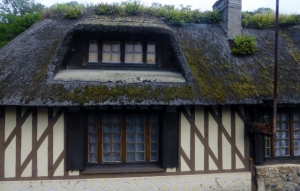 steep slate roofs with small dormer windows and timber slats on walls.
steep slate roofs with small dormer windows and timber slats on walls.
The countryside was lush and cattle, no doubt producing the milk for Normandy’s famous cheeses—Camembert and Pont L’Eveque being two of my favourites—looked very contented.
Arriving in Honfleur, we could see that this was a working fishing port, as well as a pretty tourist town. 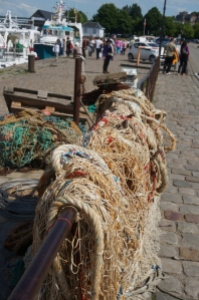 Fishing nets hanging over timber rails were not just decorative, although they did provide some interesting photos. On one side of the harbor, where we left the buses, fishing boats were lined up and men wearing work clothes attended to their nets, engines and whatever else fishermen need to do.
Fishing nets hanging over timber rails were not just decorative, although they did provide some interesting photos. On one side of the harbor, where we left the buses, fishing boats were lined up and men wearing work clothes attended to their nets, engines and whatever else fishermen need to do. 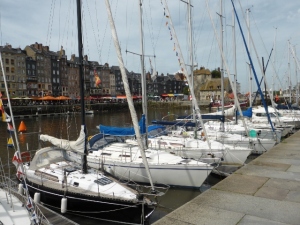 Hundreds of pleasure boats were also moored here and all around the harbor.
Hundreds of pleasure boats were also moored here and all around the harbor.
Our tour guide led us to the oldest part of the town.
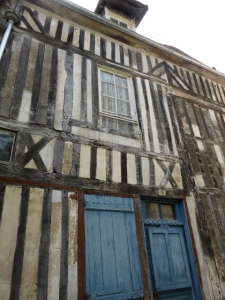 We were busy photographing ancient timber buildings, cobbled streets and quaint shops as we followed him along narrow streets to France’s largest wooden church,
We were busy photographing ancient timber buildings, cobbled streets and quaint shops as we followed him along narrow streets to France’s largest wooden church,
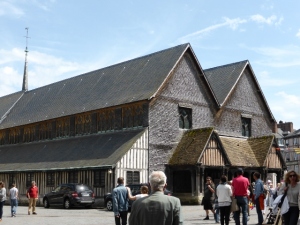 Saint Catherine’s, which stands on one side of the square and its bell tower is a separate building on the other side.
Saint Catherine’s, which stands on one side of the square and its bell tower is a separate building on the other side.
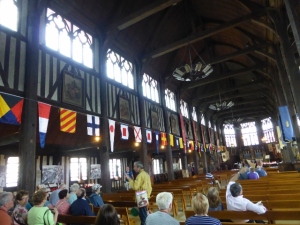 Inside the church we found stained glass windows and the usual religious statues, but in addition, children had made model boats and the low (for a church) ceiling was decorated with colourful flags. They must have been preparing for a special day for the fishing fleet.
Inside the church we found stained glass windows and the usual religious statues, but in addition, children had made model boats and the low (for a church) ceiling was decorated with colourful flags. They must have been preparing for a special day for the fishing fleet.
Our guide left us then, to wander back through the same narrow streets, most of us heading for an ice cream parlour we noticed on the way, next to a chocolate shop. Afternoon tea sorted.
Then we walked across the stone paved bridge which separates the ancient from the merely old side on Honfleur. Here the houses were painted blue, grey, pale peach; four or five stories high, some of them were only one room wide. And below them, lining the waterfront, were cafes and restaurants with red awnings.
Artists stood or sat, brush in hand, capturing the picturesque buildings, their colourful reflections in the water, or the white boats anchored nearby.
We wandered again, on more modern streets, dodging cars and vans until we came to an open area beside the water, where a group of English men were singing a cappella.
They were too engrossed in the performance to talk, but a bystander told us that they were practicing for a competition being held over the weekend.
We wanted to stay longer; it was one of those magical, unexpected experiences that make travel so enjoyable, but if we didn’t get back to our bus on time we could be in trouble. As it was, we had to walk very fast, getting rid of much of the effect of those yummy ice creams
